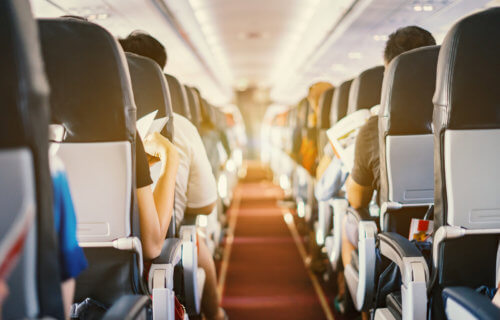ATLANTA — Contrary to popular belief, the place indoors with the lowest levels of particulate pollution is actually inside a plane cabin at cruising altitude, scientists reveal.
The news comes as more people are taking to the air again for travel since the start of the COVID-19 pandemic. It highlights the low risk of catching the virus on a plane, while pointing to which places have dirtier air.
In July 2020 researchers at the Georgie Institute of Technology studied air quality in indoor spaces including shops, restaurants, offices, public transport and commercial jets. Their study shows that the latter had the lowest levels of tiny aerosol particles.
“We wanted to highlight how important it is to have a high ventilation rate and clean air supply to lower the concentration of particles in indoor spaces,” says Nga Lee “Sally” Ng, an associate professor with Georgia Tech’s School of Chemical and Biomolecular Engineering and the School of Earth and Atmospheric Sciences, in a statement. “The in-flight cabin had the lowest particle mass and particle number concentration.”
The team studied both the number of particles and their total mass across the broad range of indoor locations, including 19 commercial flights. Among all the spaces measured, restaurants had the highest particle levels because of cooking being done there. Shops were next, followed by cars and buses, homes, and offices.
In flight, aircraft air is exchanged between 10 and 30 times per hour. Some aircraft bring in exclusively outside air, which at cruising altitude is largely free of pollutant particles found in air near the ground. Other aircraft mix outdoor air with recirculated air that goes through HEPA filters, which remove more than 99% of particles.
Measurements took place throughout departure and arrival terminals, the boarding process, taxiing, climbing, cruising, descent, and disembarkation. The monitoring could not identify the types of the particles and therefore does not provide a direct measure of coronavirus exposure risk but improving indoor air quality would reduce coronavirus transmission.
“Regardless of whether you are in an office or an aircraft, having a higher ventilation rate and good particle filtration are the keys to reducing the total particle concentration,” says Ng. “That should also reduce the concentration of any viral particles that may be present.”
The study, published in the journal Indoor Air, is the first to comprehensively measure particle concentrations likely to be encountered by passengers from terminal to terminal. Infected people can spread the virus as they breathe, talk, or cough, creating particles ranging in size from less than a micron (one millionth of a meter), to 1,000 microns.
The larger particles quickly fall out of the air, but the smaller ones remain suspended.
As scientists learn more about transmission of the coronavirus, the focus has turned to aerosol particles as an important source of viral spread indoors.
“Especially in poorly ventilated spaces, these particles can be suspended in the air for a long period of time, and can travel to every corner of a room,” says Ng. “If they are viral particles, they can infect people who may be at a considerable distance from a person emitting the particles.”
The research came about when Delta Airlines approached the team to try and ascertain if there was more they could do during the pandemic.
Using handheld instruments able to measure the total number of particles and their mass, Georgia Tech researchers examined air quality in a series of Atlanta area restaurants, stores, offices, homes, and vehicles including buses, trains, and cars. They trained Delta staff to conduct the same type of measurements in terminals, boarding areas, and a variety of aircraft through all phases of flight.
The Delta staff recorded their locations as they moved through the terminals, and the instruments produced measurements consistent with the restaurants and stores they passed on their way to and from boarding and departure gates. In all, the researchers evaluated measurements from 19 commercial flights with passenger loads of approximately 50%.
The flights included a mix of short- and medium-length different types of aircraft.
SWNS writer Jim Leffman contributed to this report.
